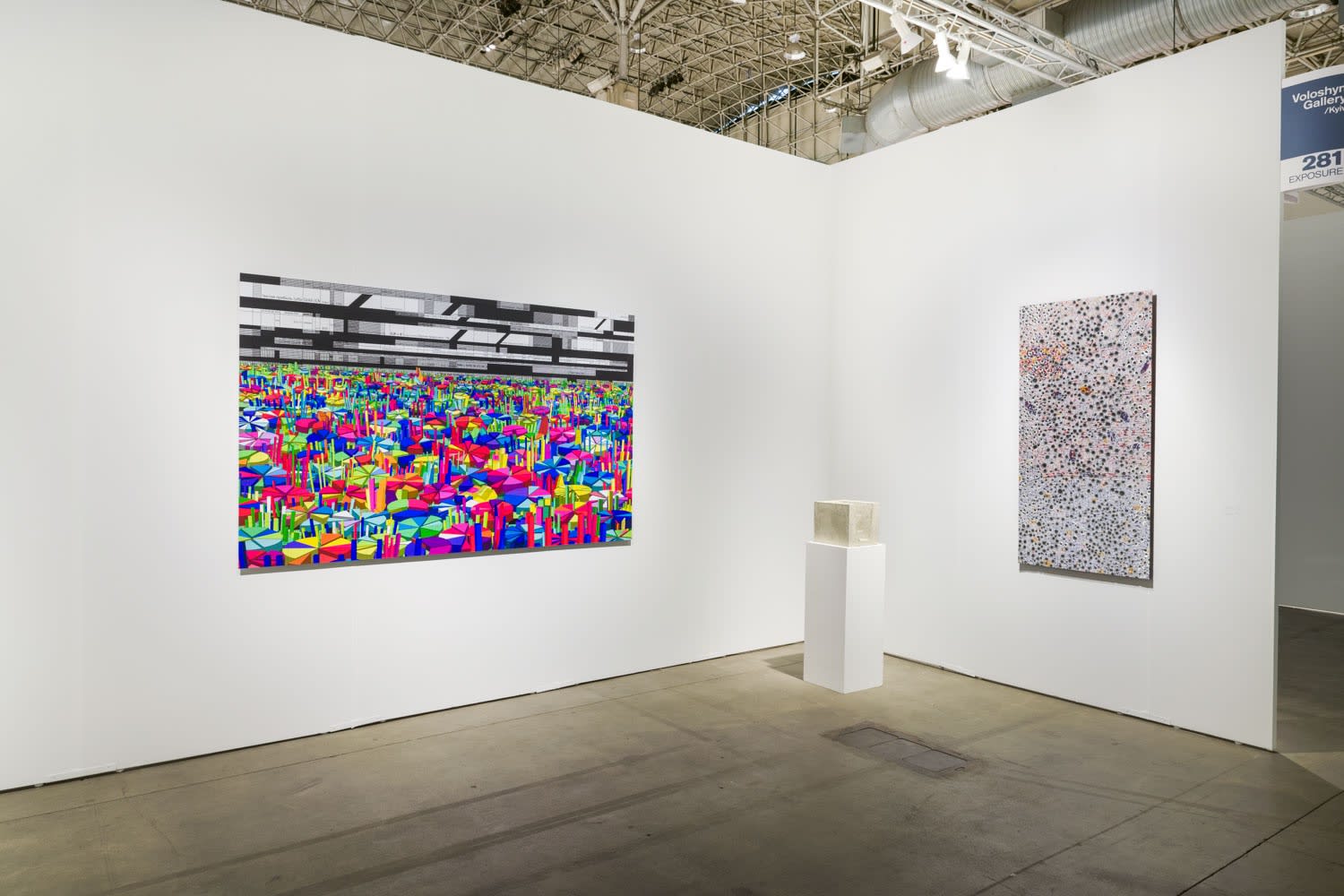EXPO CHICAGO 2023
Voloshyn Gallery представляє груповий проєкт Миколи Рідного та Олексія Сая на EXPO CHICAGO.
Цей проєкт є продовженням рефлексії навколо війни, що триває в Україні. Художники заглиблюються в дослідження середовища, конкретних територій та їх долею, поєднуючи індивідуальний досвід з загальносуспільним.
Олексій Сай представляє свої роботи із серії “Розбомблені”, що являють собою зображення з висоти пташиного польоту ландшафтів сходу України зі слідами-кратерами від вибухів, залишених війною. За допомогою болгарки, дрилі та абразиву Сай майже повністю знищує поверхню своїх попередніх робіт з різних серій, різних років і розмірів, перетворюючи їх на фактурні мапи руйнувань. Поступово втрачаючи чіткість початкового зображення, роботи стають майже абстрактними, але при цьому наповнені цілком конкретним змістом. Серія була розпочата художником ще 2015 року як реакція на поточні події в країні. Своєрідна терапія, яка допомагала “зайняти руки і голову” та через виснажливу монотонну дію віддати матеріалу бодай частку складних емоцій, пов’язаних із переживанням поточних подій. Не маючи наміру безпосередньо закарбувати тривогу чи біль, художник радше прагнув через сам медитативно-мазохістський процес одночасного творення і деструкції “налаштуватися на одну хвилю з оточуючою дійсністю”. 2018 року роботи акумулювалися вже в повноцінну серію, а отвори на них із відокремлених пробоїн поступово трансформуються на масований абстрактний візерунок, де початкове зображення вже не розпізнати.
Скульптура Миколи Рідного з серії “Укриття" вступає у діалог із роботами Олексія Сая, створюючи цікаву та емоційну композицію. Історія проєкту Рідного почалася ще в його шкільні часи, коли він відвідував заняття з Цивільної оборони, що проходили в реальному бомбосховищі, розташованому під школою. У основі серії бетонних скульптур лежать моделі бомбосховищ. Під час холодної війни пропаганда СРСР та США породила соціофобію, пов’язану із загрозою ядерної війни та культом "захисту вітчизни". Вже за часів незалежності України багато укриттів, створених радянською владою, залишилися покинуті та закриті, інші були переобладнані для інших потреб: від побутових сховищ до тренувальних залів або секонд-хендів. Серія робіт Миколи Рідного, виконана у 2012-2013 роках, що представляє укриття як реліквію та явище, набула нового значення у 2014 році, після російського вторгнення на сході України, та особливо у 2022 році, коли російська федерація почала повномаштабний наступ на територію України. Тоді укриття повернулися до своєї первинної функції, в тому числі в школах. А багато випускників таких шкіл були призвані в армію, або ж вступили до добровольчих військових батальйонів, щоб зіткнутись вже з реальною війною.
Про Миколу Рідного
Микола Рідний народився в Харкові (1985), живе і працює в Києві. У 2005 став співзасновником групи SOSка і однойменної галереї-лабораторії в Харкові. Працює з різними медіа, як то фотографія, відео, колаж, інсталяція та скульптура. Виступав куратором ряду мистецьких проєктів, крайній з яких – «Озброєні та небезпечні» (2019) існує у формі відео-виставки, кіно-альманаху та онлайн-платформи. Роботи Миколи Рідного демонструвалися в багатьох галереях України та за кордоном, зокрема Pinakothek der Moderne (Мюнхен), daad galerie (Берлін), Transmediale (Берлін), Center for Art and Media (Карлсруе), Galerie für Zeitgenössische Kunst (Лейпциг), Музей сучасного мистецтва (Варшава) і Bonniers Konsthall (Стокгольм). Митець отримав низку стипендій, у тому числі запропонованих Берлінською академією мистецтв, Iaspis (Стокгольм) і Gaude Polonia (Краків).
Художник двічі брав участь в Національному павільйоні України на Венеціанській бієнале (2013, 2015), а також в основному проєкті бієнале «All the World’s Futures» (2015). Його робота «Втрачений багаж» (2019), створена для 12-ї бієнале в Каунасі, була включена в постійну експозицію музею-меморіалу Голокосту IX Форт (Каунас). Інші роботи художника знаходяться в публічних колекціях Pinakothek der Moderne (Мюнхен), Neuer Berliner Kunstverein (Берлін), Музеї сучасного мистецтва (Варшава), Музеї Людвіга (Будапешт) та інших.
Про Олексій Сай
Олексій Сай народився у 1975 році у Києві, де живе та працює і нині. У 1993 році закінчив Київський художньо-промисловий технікум, відділення графічного дизайну. У 2001 році закінчив Національну академію образотворчого мистецтва і архітектури, відділення станкової графіки. З 2001 року він швидко увійшов у сферу сучасного мистецтва, і зараз він відомий як засновник Excel-Art, Олексій охоплює й інші сегменти корпоративного світу, покликані бути засобом спілкування, але не як художня мова. Він також створює інсталяції, арт-об’єкти, цифрове мистецтво та графіку. Номінант премії PinchukArtCentre 2009 року. Олексій Сай брав участь у багатьох групових та персональних проєктах в Україні та закордоном. Так роботи художника експонувались у Black Square Gallery (Маямі, США), Saatchi Gallery (Лондон, Велика Британія), Bunsen Goertz Gallery (Нюрнберг, Німеччина), Його роботи представлені в колекціях аукціонних будинків, таких як Phillips de Pury, ArtCurial, а також у приватних колекціях Західної та Східної Європи.
Про Voloshyn Gallery
Voloshyn Gallery, заснована в жовтні 2016 року Максом і Юлією Волошиними, спеціалізується на сучасному мистецтві. Галерея демонструє широкий спектр робіт у різноманітних медіа, проводить персональні та групові виставки та бере участь у провідних ярмарках сучасного мистецтва. Протягом останніх двох років галерея брала участь у The Armory Show, Art Cologne, Enter Art Fair, Liste Basel, Viennacontemporary, Dallas Art Fair, NADA Miami, Untitled Art, Art Athina, EXPO Chicago тощо. Voloshyn Gallery є членом New Art Dealers Alliance (NADA).
Про EXPO CHICAGO
EXPO CHICAGO — міжнародна виставка сучасного мистецтва, включає провідні міжнародні галереї поряд із найякіснішою платформою для сучасного мистецтва та культури. У 2023 році EXPO CHICAGO прийме 170 провідних міжнародних експонентів у Festival Hall Navy Pier. З моменту свого заснування EXPO CHICAGO продовжує підтримувати місцеві, регіональні та міжнародні мистецькі спільноти, маючи потужну регіональну підтримку на всьому Середньому Заході, обох узбережжях США, і підтримує зростаючу міжнародну прихильність Європи, Азії та Латинської Америки.
З усіма запитаннями преси звертайтеся:
Анна Копилова
annakopylova.voloshyngallery.art@gmail.com





